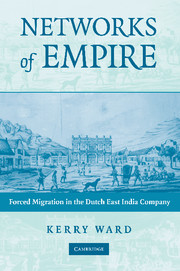Book contents
- Frontmatter
- Contents
- List of Maps
- Acknowledgments
- 1 Networks of Empire and Imperial Sovereignty
- 2 The Evolution of Governance and Forced Migration
- 3 Crime and Punishment in Batavia, circa 1730 to 1750
- 4 The Cape Cauldron: Strategic Site in Transoceanic Imperial Networks
- 5 Company and Court Politics in Java: Islam and Exile at the Cape
- 6 Forced Migration and Cape Colonial Society
- 7 Disintegrating Imperial Networks
- Bibliography
- Index
- VOC Shipping Networks
- References
5 - Company and Court Politics in Java: Islam and Exile at the Cape
Published online by Cambridge University Press: 30 July 2009
- Frontmatter
- Contents
- List of Maps
- Acknowledgments
- 1 Networks of Empire and Imperial Sovereignty
- 2 The Evolution of Governance and Forced Migration
- 3 Crime and Punishment in Batavia, circa 1730 to 1750
- 4 The Cape Cauldron: Strategic Site in Transoceanic Imperial Networks
- 5 Company and Court Politics in Java: Islam and Exile at the Cape
- 6 Forced Migration and Cape Colonial Society
- 7 Disintegrating Imperial Networks
- Bibliography
- Index
- VOC Shipping Networks
- References
Summary
The Cape of Good Hope was a crucial node in the Company's circuit of political exile emanating from Batavia. Although no coherent policy or overarching strategy governed the Company's use of exile, it became an important political tool in relations with indigenous polities because the Company could physically remove and relocate individuals who threatened its interests. The High Government used exile in much the same way as did indigenous polities who had their own circuits of exile within networks of forced migration. The Company's use of exile reveals the strengths and the limitations of its imperial nodes and networks. Company sites like Colombo, one of its most secure nodes, nevertheless intersected with indigenous Indian Ocean networks of religion, culture and communication the Company could not control. While the Company could impose physical restraints on people it exiled, it could not completely restrict their ability to communicate with and promulgate alternative networks of authority.
The Cape of Good Hope demonstrates very clearly the limits of Company sovereignty, to, on the one hand, be the only Company node completely outside indigenous Indian Ocean networks and, on the other, a site where these networks were extended through the agency of exiles and slaves themselves who transmitted Islam to the southernmost tip of Africa. Religious leaders banished in the Batavia-Cape exile circuit became powerful and sometimes charismatic nodes in and of themselves as condensed points for the transmission and transformation of Islamic practice.
- Type
- Chapter
- Information
- Networks of EmpireForced Migration in the Dutch East India Company, pp. 179 - 238Publisher: Cambridge University PressPrint publication year: 2008



